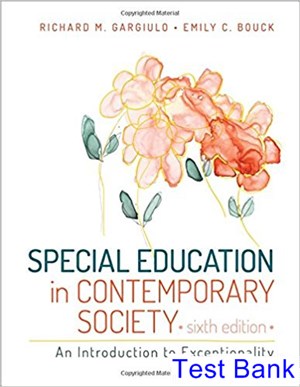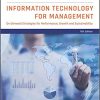Special Education in Contemporary Society An Introduction to Exceptionality 6th Edition Gargiulo Test Bank
$35.00 Original price was: $35.00.$26.50Current price is: $26.50.
Special Education in Contemporary Society An Introduction to Exceptionality 6th Edition Gargiulo Test Bank
Special Education in Contemporary Society An Introduction to Exceptionality 6th Edition Gargiulo Test Bank

Product details:
- ISBN-10 : 1506310702
- ISBN-13 : 978-1506310701
- Author: Richard Gargiulo
The Sixth Edition of Richard Gargiulo’s well-respected Special Education in Contemporary Society: An Introduction to Exceptionality offers a comprehensive, engaging, and easy-to-read introduction to special education. Grounded in research and updated to reflect the most current thinking and standards of the field, the book provides students with the skills and knowledge to become successful teachers. Richard Gargiulo and new co-author Emily Bouck encourage a deep awareness and understanding of the human side of special education. Their book provides students a rare look into the lives of exceptional students and their families, as well as the teachers that work with exceptional persons throughout their lives.
Table contents:
Chapter 1 • Special Education in Context: People, Concepts, and Perspectives
Definitions and Terminology
Categories and Labels
Prevalence of Children and Young Adults With Disabilities
A Brief History of the Development of Special Education
Cooperative Teaching
Universal Design for Learning
Exceptionality Across the Life Span
Chapter 2 • Policies, Practices, and Programs
Litigation and Legislation Affecting Special Education
Educational Reform: Standards-Based Education
Civil Rights Legislation
Identification and Assessment of Individual Differences
Referral and Assessment for Special Education
Designing Individualized Instructional Programs
Service Delivery Options: Where a Special Education Is Provided
Chapter 3 • Cultural and Linguistic Diversity and Exceptionality
Cultural Diversity: The Changing Face of a Nation
Multicultural Education, Bilingual Education, and Student Diversity
Disproportionate Representation of Minority Students in Special Education Programs
Issues in Assessing Students From Culturally and Linguistically Diverse Groups
Educational Programming for Students With Exceptionalities Who Are Culturally and Linguistically Diverse
Chapter 4 • Parents, Families, and Exceptionality
Parent–Professional Relationships: Changing Roles
A Family Systems Approach
The Effects of a Child’s Disability on Parents and the Family
Stages of Parental Reaction to Disability
Disability and the Family
Working With Families Who Are Culturally and Linguistically Diverse
Cultural Reactions to Disability
Suggestions for Facilitating Family and Professional Partnerships
Chapter 5 • Assistive Technology
Technology in Education
Assistive Technology
History and Legislation of Assistive Technology
Assistive Technology Decision Making
Assistive Technology and the IEP
Assistive Technology Categorization
Devices and Tools
Issues With Assistive Technology
Assistive Technology Future Trends
PART 2 • A STUDY OF INDIVIDUALS WITH EXCEPTIONALITIES
Chapter 6 • Individuals With Intellectual Disability
Defining Intellectual Disability: An Evolving Process
Assessing Intellectual Ability and Adaptive Behavior
Classification of Individuals With Intellectual Disability
A Brief History of the Field
Prevalence of Intellectual Disability
Etiology of Intellectual Disability
Characteristics of Individuals With Intellectual Disability
Educational Considerations
Technology and Individuals With Intellectual Disability
Services for Young Children With Intellectual Disability
Transition Into Adulthood
Adults With Intellectual Disability
Family Issues
Issues of Diversity
Trends, Issues, and Controversies
Chapter 7 • Individuals With Learning Disabilities
Defining Learning Disabilities
A Brief History of the Field
Prevalence of Learning Disabilities
Etiology of Learning Disabilities
Characteristics of Individuals With Learning Disabilities
Assessment of Learning Disabilities
Educational Considerations
Technology and Individuals With Learning Disabilities
Services for Young Children With Learning Disabilities
Transition Into Adulthood
Adults With Learning Disabilities
Family Issues
Issues of Diversity
Trends, Issues, and Controversies
Chapter 8 • Individuals With Attention Deficit Hyperactivity Disorder
Defining Attention Deficit Hyperactivity Disorder
A Brief History of the Field
Prevalence of Attention Deficit Hyperactivity Disorder
Etiology of Attention Deficit Hyperactivity Disorder
Characteristics of Individuals With Attention Deficit Hyperactivity Disorder
Assessment of Attention Deficit Hyperactivity Disorder
Educational Considerations
Technology and Individuals With Attention Deficit Hyperactivity Disorder
Adolescents and Adults With Attention Deficit Hyperactivity Disorder
Issues of Diversity
Chapter 9 • Individuals With Emotional or Behavioral Disorders
Defining Emotional or Behavioral Disorders
Classification of Individuals With Emotional or Behavioral Disorders
A Brief History of the Field
Prevalence of Emotional or Behavioral Disorders
Etiology of Emotional or Behavioral Disorders
Prevention of Emotional or Behavioral Disorders
Characteristics of Children and Youth With Emotional or Behavioral Disorders
Assessing Students With Emotional or Behavioral Disorders
Educational Considerations
Technology and Individuals With Emotional or Behavioral Disorders
Services for Young Children With Emotional or Behavioral Disorders
Transition Into Adulthood
Adults With Emotional or Behavioral Disorders
Family-Centered Interventions
Issues of Diversity
Trends, Issues, and Controversies
Chapter 10 • Individuals With Autism Spectrum Disorders
Defining Autism Spectrum Disorders: An Evolving Process
A Brief History of the Field
Prevalence of Autism Spectrum Disorders
Etiology of Autism Spectrum Disorders
Characteristics of Individuals With Autism Spectrum Disorders
Assessment of Autism Spectrum Disorders
Educational Considerations
Technology and Individuals With Autism Spectrum Disorders
Services for Young Children With Autism Spectrum Disorders
Transition Into Adulthood
Adults With Autism Spectrum Disorders
Family Issues
Issues of Diversity
Trends, Issues, and Controversies
Chapter 11 • Individuals With Speech and Language Impairments
The Nature of Speech, Language, and Communication
Defining Speech and Language Impairments
Classifying Speech and Language Impairments
Historical Perspectives
Prevalence of Speech and Language Impairments
Etiology of Speech and Language Impairments
Prevention of Speech and Language Impairments
Characteristics of Individuals With Speech and Language Impairments
Assessing Speech and Language Impairments
Educational Considerations
Technology and Individuals With Speech and Language Impairments
Services for Young Children With Speech and Language Impairments
Adolescents and Adults With Speech and Language Impairments
Family Issues
Issues of Diversity
Trends, Issues, and Controversies
Chapter 12 • Individuals With Hearing Impairments
Definitions and Concepts of Hearing Impairment
A Brief History of the Field
Prevalence of Hearing Impairment
Etiology of Hearing Impairment
Characteristics of Individuals With Hearing Impairments
Assessment of Individuals With Hearing Impairments
Educational Considerations
Technology and Individuals With Hearing Impairments
Services for Young Children With Hearing Impairments
Transition and Individuals With Hearing Impairments
Services for Adults With Hearing Impairments
Family Issues
Issues of Diversity
Trends, Issues, and Controversies
Chapter 13 • Individuals With Visual Impairments
Defining Visual Impairments
The Eye and How It Works
Classification of Visual Impairments
A Brief History of Visual Impairments
Prevalence of Visual Impairments
The Vision Process and Etiology of Visual Impairments
Prevention of Visual Impairments
Characteristics of Individuals With Visual Impairments
Assessment of Students With Visual Impairments
Educational Considerations
Orientation and Mobility
Technology and Individuals With Visual Impairments
Young Children With Visual Impairments
Transition Into Adulthood
Adults With Visual Impairments
Family Issues
Issues of Diversity
Trends, Issues, and Controversies
Chapter 14 • Individuals With Physical Disabilities, Health Disabilities, and Related Low-Incidence Disabilities
Defining Physical Disabilities, Health Disabilities, and Related Low-Incidence Disabilities
A Brief History of the Field
Prevalence of Physical Disabilities, Health Disabilities, and Related Low-Incidence Disabilities
Etiology of Physical Disabilities, Health Disabilities, and Related Low-Incidence Disabilities
Characteristics of Individuals With Physical Disabilities, Health Disabilities, and Related Low-Incidence Disabilities
Assessment of Students With Physical Disabilities, Health Disabilities, and Related Low-Incidence Disabilities
Educational Considerations
Technology and Individuals With Physical Disabilities, Health Disabilities, and Related Low-Incidence Disabilities
Services for Young Children With Physical Disabilities, Health Disabilities, and Related Low-Incidence Disabilities
Transition Into Adulthood
Adults With Physical Disabilities, Health Disabilities, and Related Low-Incidence Disabilities
Family Issues
Issues of Diversity
Trends, Issues, and Controversies
Chapter 15 • Individuals Who Are Gifted and Talented
Defining Giftedness: Refining the Meaning
Assessing Giftedness and Talent
Differences Among Children Who Are Gifted and Talented
A Brief History of the Field of Gifted and Talented Education
Prevalence of Giftedness and Talent
Etiology of Giftedness and Talent
Characteristics of Individuals Who Are Gifted and Talented
Educational Considerations
Technology and Individuals Who Are Gifted and Talented
Services for Young Children Who Are Gifted and Talented
Adolescents Who Are Gifted and Talented
Family Issues
Issues of Diversity
Trends, Issues, and Controversies
Postscript
Appendix A: Federal Definitions of Disabilities
Appendix B: Professional Standards: Council for Exceptional Children
Glossary
References
Author Index
Subject Index
Related products
Test Bank
Test Bank for Essentials of Business Law and the Legal Environment, 11th Edition: Richard A. Mann











